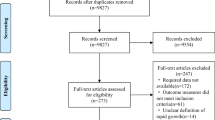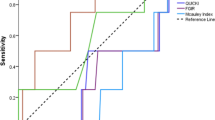Abstract
Background
The aim of this study is to investigate the TyG index and TG/HDL-C ratio and their relationships with insulin resistance in LGA infants.
Methods
A prospective controlled study was conducted including 65 LGA and gestational age, gender-matched appropriate for gestational age (AGA) neonates. Serum TG, total cholesterol (TC), high-density lipoprotein-cholesterol (HDL-C), insulin and glucose levels were measured within two hours after birth, TyG index and HOMA-IR values were calculated.
Results
TyG index and TG/HDL- C ratio were higher in LGA neonates compared to AGA ones (p = 0.03; p = 0.00, respectively). Compared with AGA newborns, LGA newborns had higher levels of insulin and HOMA-IR (p = 0.00; p = 0.00, respectively). TyG index and TG/HDL-C ratio showed moderate correlation with HOMA-IR (r = 0.59 R2 = 0.35 p < 0.001; r = 0.5 R2 = 0.25 p < 0.001, respectively).
Conclusıon
The results of this study show that LGA newborns have increased levels of TyG index and TG/HDL-C associated with insulin resistance.
This is a preview of subscription content, access via your institution
Access options
Subscribe to this journal
Receive 12 print issues and online access
$259.00 per year
only $21.58 per issue
Buy this article
- Purchase on Springer Link
- Instant access to full article PDF
Prices may be subject to local taxes which are calculated during checkout

Similar content being viewed by others

Data availability
The data is available for this study.
References
Xu H, Simonet F, Luo ZC. Optimal birth weight percentile cut-offs in defining small- or large-for-gestational-age. Acta Paediatr. 2010;99:550–5.
Freemark M. Placental hormones and the control of fetal growth. J Clin Endocrinol Metab. 2010;95:2054–7.
Kim SY, Sharma AJ, Sappenfield W, Wilson HG, Salihu HM. Association of maternal body mass index, excessive weight gain, and gestational diabetes mellitus with large-for-gestational-age births. Obstet Gynecol. 2014;123:737–44.
Van Lieshout RJ, Boyle MH. Is bigger better? Macrosomia and psychopathology later in life. Obes Rev. 2011;12:e405–411.
Weissmann-Brenner A, Simchen MJ, Zilberberg E, Kalter A, Weisz B, Achiron R, et al. Maternal and neonatal outcomes of large for gestational age pregnancies. Acta Obstet Gynecol Scand. 2012;91:844–9.
Garcia Carrapato MR. The offspring of gestational diabetes. J Perinat Med. 2003;31:5–11.
Evagelidou EN, Kiortsis DN, Bairaktari ET, Giapros VI, Cholevas VK, Tzallas CS, et al. Lipid profile, glucose homeostasis, blood pressure, and obesity-anthropometric markers in macrosomic offspring of nondiabetic mothers. Diabetes Care. 2006;29:1197–201.
Chiavaroli V, Giannini C, D’Adamo E, de Giorgis T, Chiarelli F, Mohn A. Insulin resistance and oxidative stress in children born small and large for gestational age. Pediatrics. 2009;124:695–702.
Darendeliler F, Poyrazoglu S, Sancakli O, Bas F, Gokcay G, Aki S, et al. Adiponectin is an indicator of insulin resistance in non-obese prepubertal children born large for gestational age (LGA) and is affected by birth weight. Clin Endocrinol. 2009;70:710–6.
Simental-Mendía LE, Castañeda-Chacón A, Rodríguez-Morán M, Guerrero-Romero F. Birth-weight, insulin levels, and HOMA-IR in newborns at term. BMC Pediatr. 2012;12:94.
Guerrero-Romero F, Simental-Mendía LE, González-Ortiz M, Martínez-Abundis E, Ramos-Zavala MG, Hernández-González SO, et al. The product of triglycerides and glucose, a simple measure of insulin sensitivity. Comparison with the euglycemic-hyperinsulinemic clamp. J Clin Endocrinol Metab. 2010;95:3347–51.
Abbasi F, Reaven GM. Comparison of two methods using plasma triglyceride concentration as a surrogate estimate of insulin action in nondiabetic subjects: triglycerides × glucose versus triglyceride/high-density lipoprotein cholesterol. Metabolism. 2011;60:1673–6.
Son DH, Lee HS, Lee YJ, Lee JH, Han JH. Comparison of triglyceride-glucose index and HOMA-IR for predicting prevalence and incidence of metabolic syndrome. Nutr Metab Cardiovasc Dis. 2022;32:596–604.
Gao JW, Hao QY, Gao M, Zhang K, Li XZ, Wang JF, et al. Triglyceride-glucose index in the development of peripheral artery disease: findings from the Atherosclerosis Risk in Communities (ARIC) Study. Cardiovasc Diabetol. 2021;20:126.
Rodríguez-Morán M, Simental-Mendía LE, Guerrero-Romero F. The triglyceride and glucose index is useful for recognising insulin resistance in children. Acta Paediatr. 2017;106:979–83.
Kim JW, Park SH, Kim Y, Im M, Han HS. The cutoff values of indirect indices for measuring insulin resistance for metabolic syndrome in Korean children and adolescents. Ann Pediatr Endocrinol Metab. 2016;21:143–8.
Gesteiro E, Bastida S, Barrios L, Sánchez-Muniz FJ. The triglyceride-glucose index, an insulin resistance marker in newborns? Eur J Pediatr. 2018;177:513–20.
Kabakoğlu Ünsür E, Kutlusoy Güçlü F. Triglyceride-to-high density lipoprotein cholesterol ratio and triglyceride-glucose index in the perinatal period of neonates. J Matern Fetal Neonatal Med. 2021;34:810–7.
Buchanan TA, Watanabe RM, Xiang AH. Limitations in surrogate measures of insulin resistance. J Clin Endocrinol Metab. 2010;95:4874–6.
Muniyappa R, Lee S, Chen H, Quon MJ. Current approaches for assessing insulin sensitivity and resistance in vivo: advantages, limitations, and appropriate usage. Am J Physiol Endocrinol Metab. 2008;294:E15–26.
Zhou W, Deng Y, Zhao H, Zhang C. Curent Status of Serum Insulin and C-Peptide Measurement in Clinical Laboratories in China. Ann Lab Med. 2022;42:428–37.
Manco M, Grugni G, Die Pietro M, Balsamo A, Di Candia S, Morino GS, et al. Triglyceridesto-HDL cholesterol ratio as screening tool for impaired glucose tolerance in obese children and adolescents. Acta Diabetol. 2016;53:493–8.
American College of Obstetricians and Gynecologists’ Committee on Practice B-O. Practice Bulletin No. 173: Fetal Macrosomia. Obstet Gynecol. 2016;128:e195–e209.
Kurtoğlu S, Hatipoğlu N, Mazıcıoğlu M, Kendirici M, Keskin M, Kondolot M. Insulin resistance in obese children and adolescents: HOMA-IR cut-off levels in the prepubertal and pubertal periods. J Clin Res Pediatr Endocrinol. 2010;2:100–6.
Kadakia R, Talbot O, Kuang A, Bain JR, Muehlbauer MJ, Stevens RD, et al. HAPO Study Cooperative Research Group. Cord Blood Metabolomics: Association With Newborn Anthropometrics and C-Peptide Across Ancestries. J Clin Endocrinol Metab. 2019;104:4459–72.
Hou RL, Jin WY, Chen XY, Jin Y, Wang XM, Shao J, et al. Cord blood C-peptide, insulin, HbA1c, and lipids levels in small- and large-for-gestational-age newborns. Med Sci Monit. 2014;20:2097–105.
Cutfield WS, Jefferies CA, Jackson WE, Robinson EM, Hofman PL. Evaluation of HOMA and QUICKI as measures of insulin sensitivity in prepubertal children. Pediatr Diabetes. 2003;4:119–25.
Seidman DS, Laor A, Gale R, Stevenson DK, Danon YL. A longitudinal study of birth weight and being overweight in late adolescence. Am J Dis Child. 1991;145:782–5.
Hermann GM, Dallas LM, Haskell SE, Roghair RD. Neonatal macrosomia is an independent risk factor for adult metabolic syndrome. Neonatology. 2010;98:238–44.
Mohd Nor NS, Lee S, Bacha F, Tfayli H, Arslanian S. Triglyceride glucose index as a surrogate measure of insulin sensitivity in obese adolescents with normoglycemia, prediabetes, and type 2 diabetes mellitus: comparison with the hyperinsulinemic-euglycemic clamp. Pediatr Diabetes. 2016;17:458–65.
Unger G, Benozzi SF, Perruzza F, Pennacchiotti GL. Triglycerides and glucose index: a useful indicator of insulin resistance. Endocrinol Nutr. 2014;61:533–40.
Krawczyk M, Ruminska M, Witkowska-Sedek E, Majcher A, Pyrzak B. Usefulness of the triglycerides to high-density lipoprotein cholesterol ratio (TG/HDL-C) in prediction of metabolic syndrome in Polish obese children and adolescents. Acta Biochim Pol. 2018;65:605–11.
Sumner AE. Ethnic differences in triglyceride levels and high-density lipoprotein lead to underdiagnosis of the metabolic syndrome in black children and adults. J Pediatr. 2009;155:S7.e7–11.
Song T, Su G, Chi Y, Wu T, Xu Y, Chen C. Triglyceride–glucose index predicts the risk of gestational diabetes mellitus: a systematic review and meta-analysis. Gynecol Endocrinol. 2022;38:10–15.
Sánchez-García A, Rodríguez-Gutiérrez R, Saldívar-Rodríguez D, Guzmán-López A, Mancillas-Adame L, González-Nava V, et al. Early triglyceride and glucose index as a risk marker for gestational diabetes mellitus. Int J Gynaecol Obstet. 2020;151:117–23.
Kim JA, Kim J, Roh E, Hong SH, Lee YB, Baik SH, et al. Triglyceride and glucose index and the risk of gestational diabetes mellitus: A nationwide population-based cohort study. Diabetes Res Clin Pr. 2021;171:108533.
Pazhohan A, Rezaee Moradali M, Pazhohan N. Association of first-trimester maternal lipid profiles and triglyceride-glucose index with the risk of gestational diabetes mellitus and large for gestational age newborn. J Matern Fetal Neonatal Med. 2019;32:1167–75.
Yajnik CS, Fall CHD, Coyaji KJ, Hirve SS, Rao S, Barker DJP, et al. Neonatal anthropometry: the thin-fat Indian baby. The Pune Maternal Nutrition Study. Int J Obes Relat Metab Disord. 2003;27:173–80.
Gillman MW, Ludwig DS. How early should obesity prevention start? N. Engl J Med. 2013;369:2173–5.
Sewell MF, Huston-Presley L, Super DM, Catalano P. Increased neonatal fat mass, not lean body mass, is associated with maternal obesity. Am J Obstet Gynecol. 2006;195:1100–3.
Herrera E, Ortega-Senovilla H. Implications of lipids in neonatal body weight and fat mass in gestational diabetic mothers and non-diabetic controls. Curr Diabetes Rep. 2018;18:7.
Mahindra MP, Sampurna MTA, Mapindra MP, Sutowo, Putri AM. Maternal lipid levels in pregnant women without complications in developing risk of large for gestational age newborns: a study of meta-analysis. F1000 Res. 2021;9:1213.
Mustafa HJ, Seif K, Javinani A, Aghajani F, Orlinsky R, Alvarez MV, et al. Gestational weight gain below instead of within the guidelines per class of maternal obesity: a systematic review and meta-analysis of obstetrical and neonatal outcomes. Am J Obstet Gynecol MFM. 2022;18:100682 https://doi.org/10.1016/j.ajogmf.2022.100682.
Buchanan TA, Watanabe RM, Xiang AH. Limitations in surrogate measures of insulin resistance. J Clin Endocrinol Metab. 2010;95:4874–6.
Author information
Authors and Affiliations
Contributions
1st author: Design and writing of the article with literature review. 2nd, and 4th author: Data analysis. 3rd,5th, and 6th author: Literature review and revision of manuscript. 7th author: Revision of the manuscript.
Corresponding author
Ethics declarations
Competing interests
The authors report no conflict of interest.
Ethical approval
The protocol was approved by the Local Ethics Committee of Etlik Zubeyde Hanım Women’s Health Training and Research Hospital, Ankara City Hospital. Informed written consent was obtained from the parents before enrollment.
Additional information
Publisher’s note Springer Nature remains neutral with regard to jurisdictional claims in published maps and institutional affiliations.
Rights and permissions
Springer Nature or its licensor (e.g. a society or other partner) holds exclusive rights to this article under a publishing agreement with the author(s) or other rightsholder(s); author self-archiving of the accepted manuscript version of this article is solely governed by the terms of such publishing agreement and applicable law.
About this article
Cite this article
Kavurt, S., Uzlu, S.E., Bas, A.Y. et al. Can the triglyceride-glucose index predict insulin resistance in LGA newborns?. J Perinatol 43, 1119–1124 (2023). https://doi.org/10.1038/s41372-022-01586-0
Received:
Revised:
Accepted:
Published:
Issue Date:
DOI: https://doi.org/10.1038/s41372-022-01586-0


